�
DISCRETE CONVEX ANALYSIS
SIAM Monographs on
Discrete Mathematics and Applications
The series includes advanced monographs reporting on the most recent theoretical, computational, or
applied developments in the field; introductory volumes aimed at mathematicians and other mathematically
motivated readers interested in understanding certain areas of pure or applied combinatorics; and graduate
textbooks. The volumes are devoted to various areas of discrete mathematics and its applications.
Mathematicians, computer scientists, operations researchers, computationally oriented natural and social
scientists, engineers, medical researchers, and other practitioners will find the volumes of interest.
Editor-in-Chief
Peter L. Hammer, RUTCOR, Rutgers, The State University of New Jersey
Editorial Board
M. Aigner, Freie Universitat Berlin, Germany
N. Alon, Tel Aviv University, Israel
E. Balas, Carnegie Mellon University, USA
J- C. Bermond, UniversitedeNice-SophiaAntipolis, France
J. Berstel, Universite Marne-la-Vallee, France
N. L. Biggs, The London School of Economics, United Kingdom
B. Bollobas, University of Memphis, USA
R. E. Burkard, Technische Universitat Graz, Austria
D. G. Cornell, University of Toronto, Canada
I. Gessel, Brandeis University, USA
F. Glover, University of Colorado, USA
M. C. Golumbic, Bar-Han University, Israel
R. L. Graham, AT&T Research, USA
A. J. Hoffman, IBM T. J. Watson Research Center, USA
T. Ibaraki, Kyoto University, Japan
H. Imai, University of Tokyo, Japan
M. Karoriski, Adam Mickiewicz University, Poland, and Emory
University, USA
R. M. Karp, University of Washington, USA
V. Klee, University of Washington, USA
K. M. Koh, National University of Singapore, Republic of
Singapore
B. Korte, Universitat Bonn, Germany
A. V. Kostochka, Siberian Branch of the Russian Academy of
Sciences, Russia
F. T. Leighton, Massachusetts Institute of Technology, USA
T. Lengauer, Gesellschaft fur Mathematik und
Datenverarbeitung mbH, Germany
S. Martello, DEIS University of Bologna, Italy
M. Minoux, Universite Pierre et Marie Curie, France
R. Mb'hring, Technische Universitat Berlin, Germany
C. L. Monma, Bellcore, USA
J. Nesetril, Charles University, Czech Republic
W. R. Pulleyblank, IBM T. J. Watson Research Center, USA
A. Recski, Technical University of Budapest, Hungary
C. C. Ribeiro, Catholic University of Rio de Janeiro, Brazil
H. Sachs, Technische Universitat llmenau, Germany
A. Schrijver, CWI, The Netherlands
R. Shamir, Tel Aviv University, Israel
N. J. A. Sloane, AT&T Research, USA
W. T. Trotter, Arizona State University, USA
D. J. A. Welsh, University of Oxford, United Kingdom
D. de Werra, Ecole Polytechnique Federate de Lausanne,
Switzerland
P. M. Winkler, Bell Labs, Lucent Technologies, USA
Yue Minyi, Academia Sinica, People's Republic of China
Series Volumes
Murota, K., Discrete Convex Analysis
Toth, P. and Vigo, D., The Vehicle Routing Problem
Anthony, M., Discrete Mathematics of Neural Networks: Selected Topics
Creignou, N., Khanna, S., and Sudan, M., Complexity Classifications of Boolean Constraint Satisfaction Problems
Hubert, L., Arable, P., and Meulman, J., Combinatorial Data Analysis: Optimization by Dynamic Programming
Peleg, D., Distributed Computing: A Locality-Sensitive Approach
Wegener, I., Branching Programs and Binary Decision Diagrams: Theory and Applications
Brandstadt, A., Le, V. B., and Spinrad, J. P., Graph Classes: A Survey
McKee, T. A. and McMorris, F. R., Topics in Intersection Graph Theory
Grilli di Cortona, P., Manzi, C., Pennisi, A., Ricca, R, and Simeone, B., Evaluation and Optimization of Electoral Systems
�
DISCRETE CONVEX ANALYSIS
KAZUO MUROTA
University of Tokyo; PRESTO, JST
Tokyo, Japan
Society for Industrial and Applied Mathematics
Philadelphia
�
Copyright © 2003 by the Society for Industrial and Applied Mathematics.
10 9 8 7 6 5 4 3 21
All rights reserved. Printed in the United States of America. No part of this book may
be reproduced, stored, or transmitted in any manner without the written permission of
the publisher. For information, write to the Society for Industrial and Applied
Mathematics, 3600 University City Science Center, Philadelphia, PA 19104-2688.
library of Congress Cataloging-in-Publication Data
Murota, Kazuo, 1955-
Discrete convex analysis / Kazuo Murota.
p. cm. — (SIAM monographs on discrete mathematics and applications)
Includes bibliographical references and index.
ISBN 0-89871-540-7
1. Convex functions. 2. Convex sets. 3. Mathematical analysis. I. Title. II. Series.
QA331.5.M87 2003
515'.8—dc21
2003042468
is a registered trademark.
�
Contents
List of Figures
Notation
Preface
1
Introduction to the Central Concepts
1.1
1.2
1.3
1.4
Aim
History
Aim and History of Discrete Convex Analysis
1.1.1
1.1.2
Useful Properties of Convex Functions
Submodular Functions and Base Polyhedra
Submodular Functions
1.3.1
1.3.2
Base Polyhedra
Discrete Convex Functions
1.4.1
1.4.2
1.4.3
1.4.4
1.4.5
L-Convex Functions
M-Convex Functions
Conjugacy
Duality
Classes of Discrete Convex Functions
Bibliographical Notes
2 Convex Functions with Combinatorial Structures
2.1
2.2
2.3
Convex Quadratic Functions
Symmetric M-Matrices
Combinatorial Property of Conjugate Functions
General Quadratic L-/M-Convex Functions
Quadratic Functions
2.1.1
2.1.2
2.1.3
2.1.4
Nonlinear Networks
2.2.1
2.2.2
2.2.3
Substitutes and Complements in Network Flows
2.3.1
Real-Valued Flows
Integer-Valued Flows
Technical Supplements
Convexity and Submodularity
v
xi
xiii
xxi
1
1
1
5
9
15
16
18
21
21
25
29
32
36
36
39
39
39
41
. . 47
51
52
52
56
58
61
61
�
vi
Contents
2.3.2
2.4 Matroids
2.4.1
2.4.2
Bibliographical Notes
Technical Supplements
63
68
Prom Matrices to Matroids
68
From Polynomial Matrices to Valuated Matroids . . 71
74
3 Convex Analysis, Linear Programming, and Integrality
Convex Analysis
Linear Programming
Integrality for a Pair of Integral Polyhedra
Integrally Convex Functions
3.1
3.2
3.3
3.4
Bibliographical Notes
4 M-Convex Sets and Submodular Set Functions
Definition
Exchange Axioms
Submodular Functions and Base Polyhedra
Polyhedral Description of M-Convex Sets
Submodular Functions as Discrete Convex Functions
4.1
4.2
4.3
4.4
4.5
4.6 M-Convex Sets as Discrete Convex Sets
4.7
4.8 M-Convex Polyhedra
Bibliographical Notes
M^-Convex Sets
5
L-Convex Sets and Distance Functions
5.1
5.2
5.3
5.4
5.5
5.6
Bibliographical Notes
Definition
Distance Functions and Associated Polyhedra
Polyhedral Description of L-Convex Sets
L-Convex Sets as Discrete Convex Sets
L^-Convex Sets
L-Convex Polyhedra
6 M-Convex Functions
Local Exchange Axiom
Examples
Basic Operations
Supermodularity
Descent Directions
6.1 M-Convex Functions and M^-Conyex Functions
6.2
6.3
6.4
6.5
6.6
6.7 Minimizers
6.8
6.9
6.10 Convex Extension
6.11
6.12
Polyhedral M-Convex Functions
Positively Homogeneous M-Convex Functions
Gross Substitutes Property
Proximity Theorem
77
77
86
90
92
99
101
101
102
103
108
Ill
114
116
118
119
121
121
122
123
125
128
131
131
133
133
135
138
142
145
146
148
152
156
158
160
164
�
Contents
6.13 Directional Derivatives and Subgradients
6.14 Quasi M-Convex Functions
Bibliographical Notes
7
L-Convex Functions and L''-Convex Functions
Discrete Midpoint Convexity
Examples
Basic Operations
L-Convex Functions
7.1
7.2
7.3
7.4
7.5 Minimizers
7.6
7.7
7.8
7.9
7.10 Directional Derivatives and Subgradients
7.11 Quasi L-Convex Functions
Bibliographical Notes
Proximity Theorem
Convex Extension
Polyhedral L-Convex Functions
Positively Homogeneous L-Convex Functions
8 Conjugacy and Duality
8.1
8.2
Conjugacy
8.1.1
8.1.2
8.1.3
Duality
8.2.1
8.2.2
8.2.3
Submodularity under Conjugacy
Polyhedral M-/L-Convex Functions
Integral M-/L-Convex Functions
Separation Theorems
Fenchel-Type Duality Theorem
Implications
8.3 M2-Convex Functions and L2-Convex Functions
8.4
M2-Convex Functions
L2-Convex Functions
Relationship
8.3.1
8.3.2
8.3.3
Lagrange Duality for Optimization
8.4.1
8.4.2
8.4.3
8.4.4
Outline
General Duality Framework
Lagrangian Function Based on M-Convexity
Symmetry in Duality
Bibliographical Notes
9 Network Flows
9.1 Minimum Cost Flow and Fenchel Duality
Minimum Cost Flow Problem
Feasibility
Optimality Criteria
Relationship to Fenchel Duality
9.1.1
9.1.2
9.1.3
9.1.4
9.2 M-Convex Submodular Flow Problem
9.3
Feasibility of Submodular Flow Problem
vii
166
168
175
177
177
180
181
183
185
186
187
189
193
196
198
202
205
205
206
208
212
216
216
221
224
226
226
229
234
234
234
235
. . .. 238
241
244
245
245
245
247
248
253
255
258
�
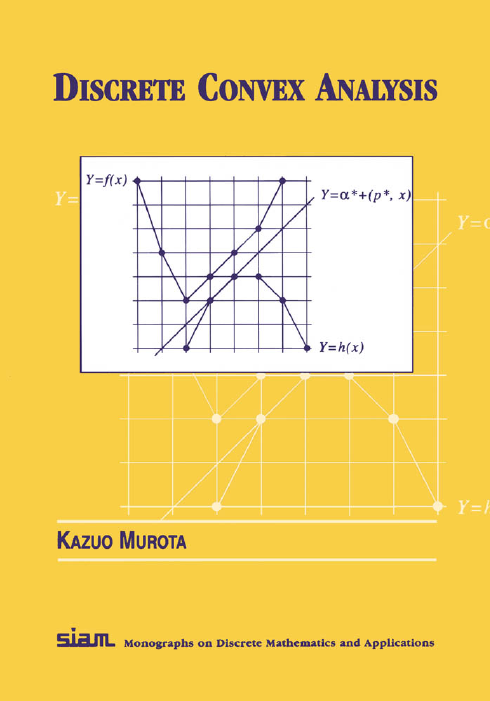
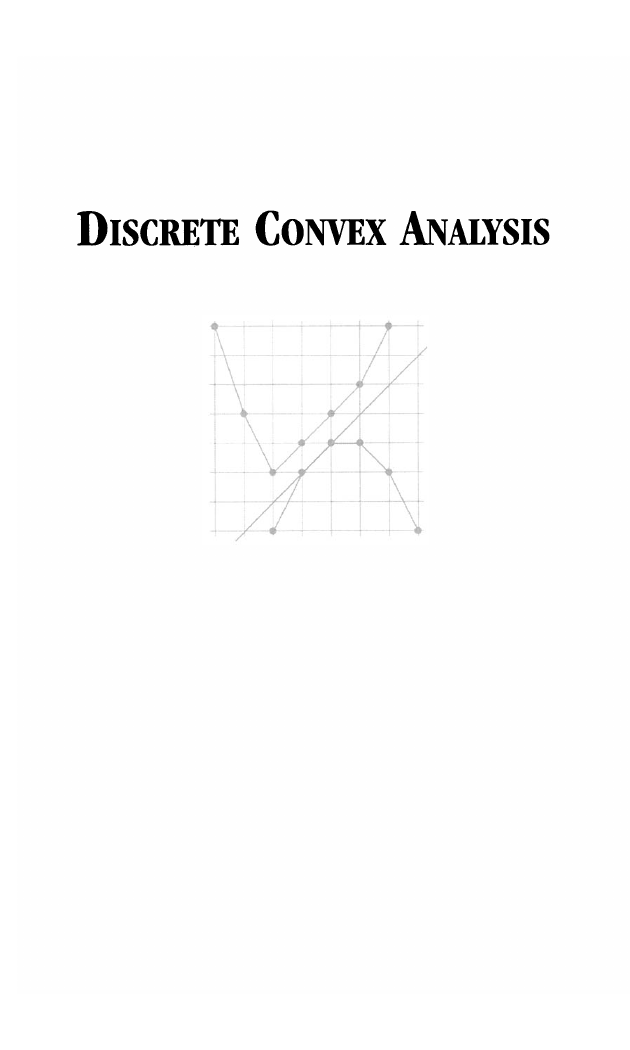
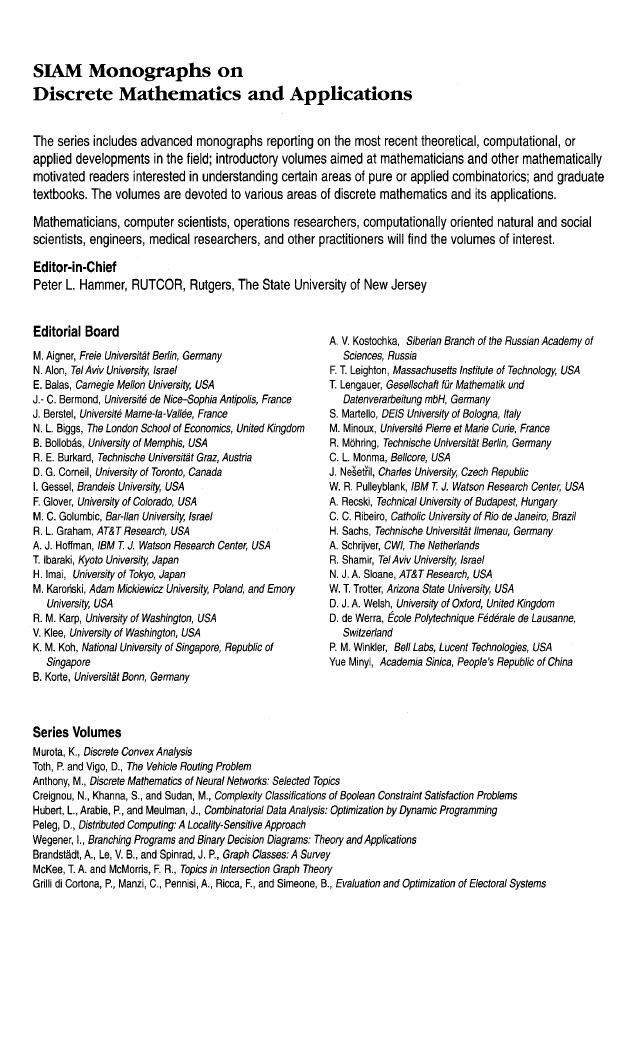

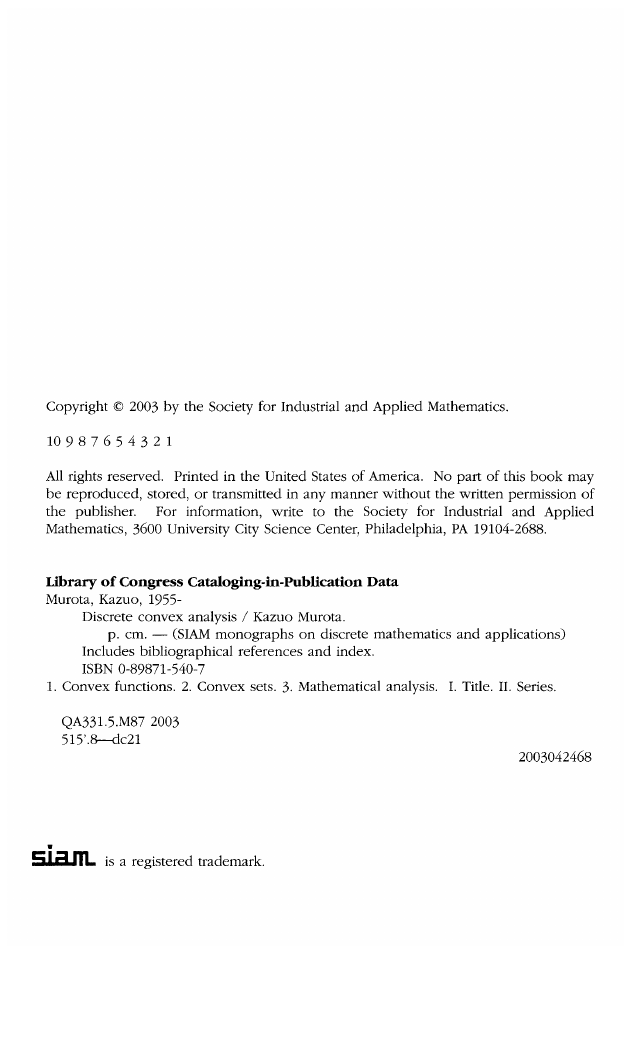
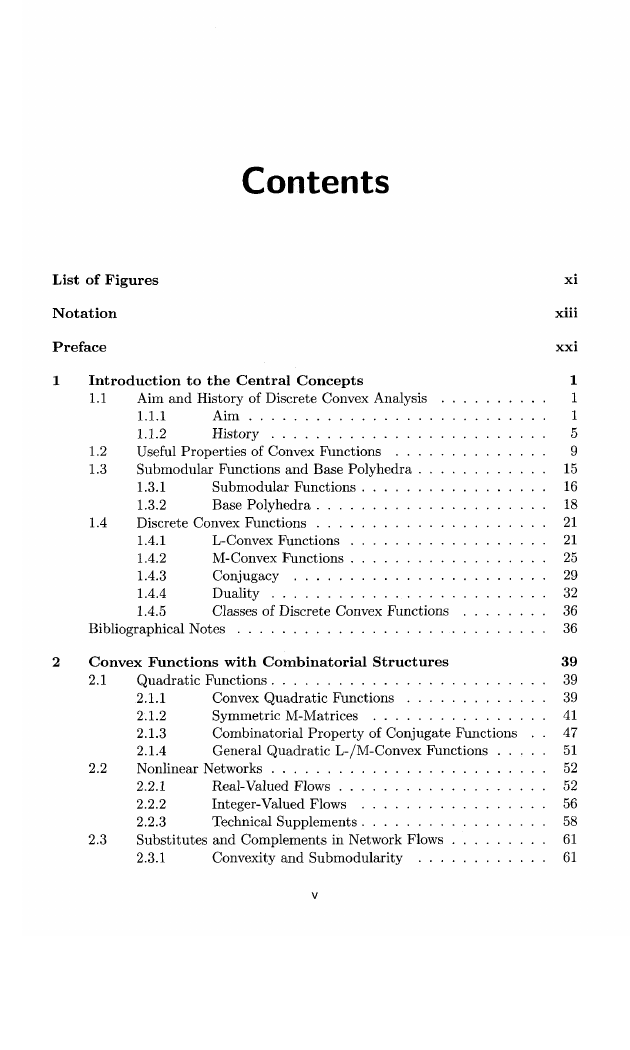
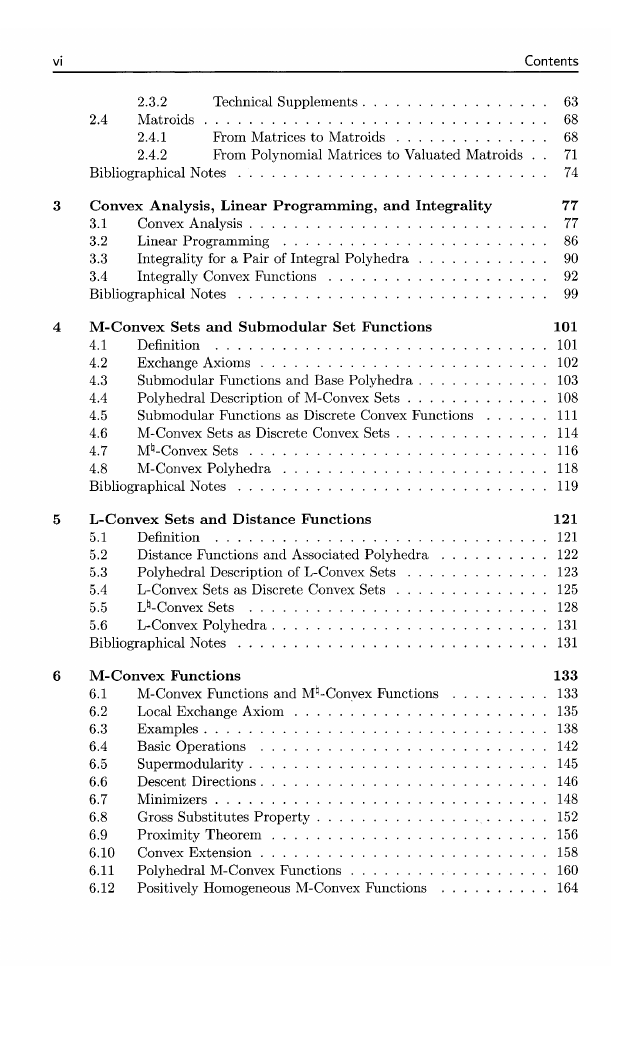
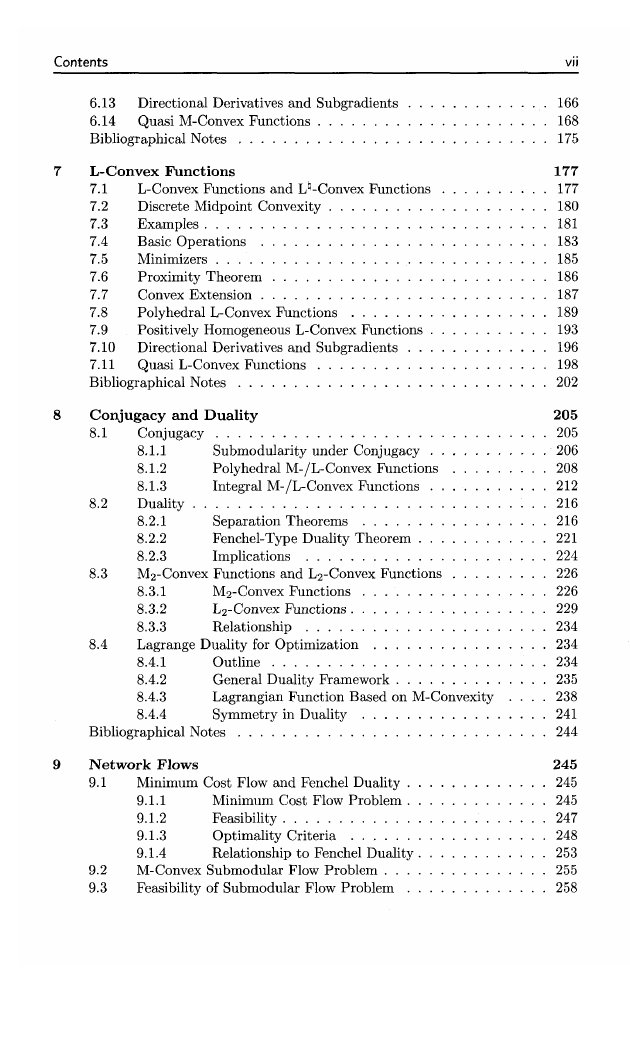








 2023年江西萍乡中考道德与法治真题及答案.doc
2023年江西萍乡中考道德与法治真题及答案.doc 2012年重庆南川中考生物真题及答案.doc
2012年重庆南川中考生物真题及答案.doc 2013年江西师范大学地理学综合及文艺理论基础考研真题.doc
2013年江西师范大学地理学综合及文艺理论基础考研真题.doc 2020年四川甘孜小升初语文真题及答案I卷.doc
2020年四川甘孜小升初语文真题及答案I卷.doc 2020年注册岩土工程师专业基础考试真题及答案.doc
2020年注册岩土工程师专业基础考试真题及答案.doc 2023-2024学年福建省厦门市九年级上学期数学月考试题及答案.doc
2023-2024学年福建省厦门市九年级上学期数学月考试题及答案.doc 2021-2022学年辽宁省沈阳市大东区九年级上学期语文期末试题及答案.doc
2021-2022学年辽宁省沈阳市大东区九年级上学期语文期末试题及答案.doc 2022-2023学年北京东城区初三第一学期物理期末试卷及答案.doc
2022-2023学年北京东城区初三第一学期物理期末试卷及答案.doc 2018上半年江西教师资格初中地理学科知识与教学能力真题及答案.doc
2018上半年江西教师资格初中地理学科知识与教学能力真题及答案.doc 2012年河北国家公务员申论考试真题及答案-省级.doc
2012年河北国家公务员申论考试真题及答案-省级.doc 2020-2021学年江苏省扬州市江都区邵樊片九年级上学期数学第一次质量检测试题及答案.doc
2020-2021学年江苏省扬州市江都区邵樊片九年级上学期数学第一次质量检测试题及答案.doc 2022下半年黑龙江教师资格证中学综合素质真题及答案.doc
2022下半年黑龙江教师资格证中学综合素质真题及答案.doc